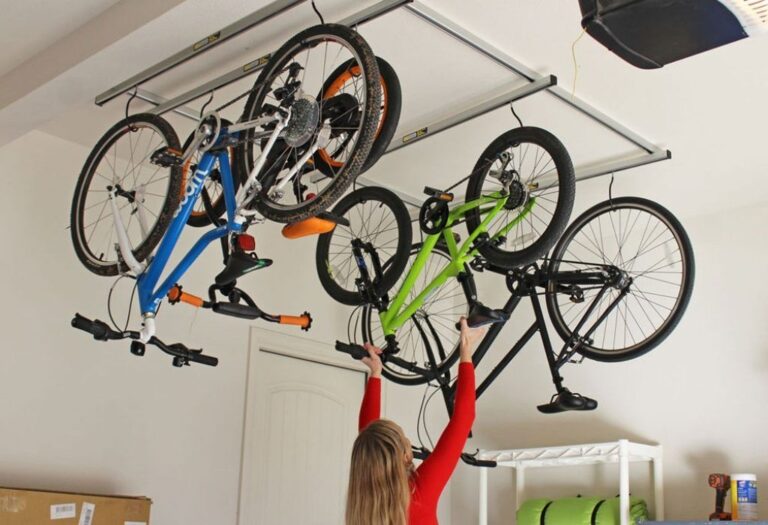Your wedding ring is one of your most cherished possessions. This small piece of jewelry symbolizes your love, commitment, and the start of a new chapter in your life. But many newlyweds have one question: where to put a wedding ring? There are no absolute rules, but there are some essential factors to consider when deciding where to wear your wedding band. In this guide, we’ll explore wedding ring-wearing etiquette, ring safety, and popular placement options to help you find the perfect spot for your ring.
Understanding Wedding Ring Etiquette
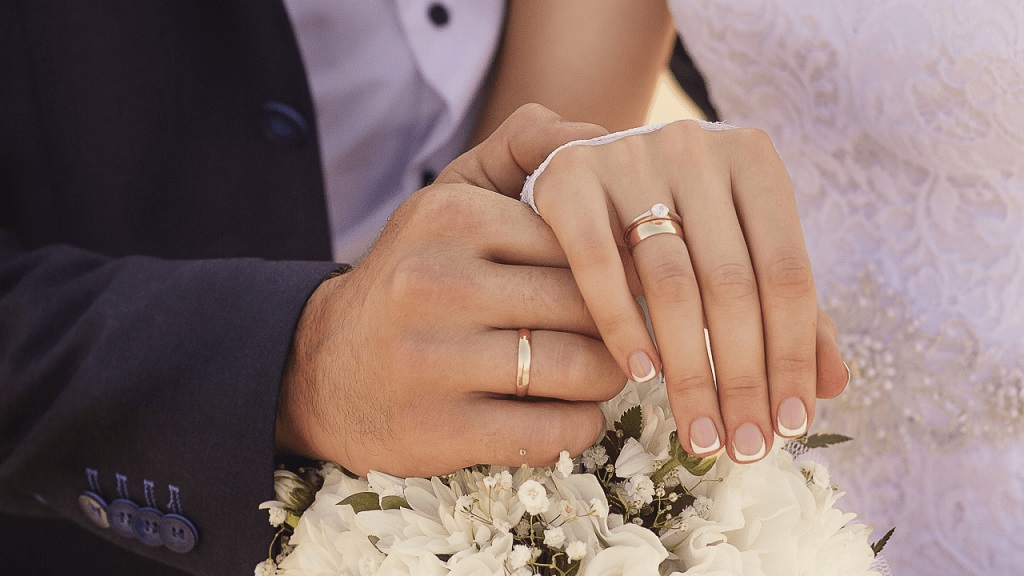
While traditions around weddings and marriage have evolved, some generally accepted etiquette guidelines exist around wedding rings. Here are a few key things to keep in mind:
- The ring finger. In most Western cultures, wedding rings are worn on the fourth finger of the left hand, between the pinky and middle finger. This tradition dates back to ancient Romans who believed this finger contained a vein that connected directly to the heart, called the vena amoris or “vein of love.” This meaning carries through in modern traditions.
- Swap hands? Some cultures, including parts of Europe, Colombia, Germany, Poland, and Spain, wear wedding bands on the right hand. Consider cultural traditions and comfort when deciding which hand is right for you.
- The ring goes on first. The wedding ring is placed on the finger before the engagement ring during the ceremony. It symbolizes your new union and goes closest to the heart.
- Remove sparingly. Wedding rings are meant to be worn at all times to honor your commitment. Some exceptions include the risk of injury during physical activities, work with machinery, or professions like health care that require frequent hand washing.
Ultimately, there is flexibility, but following cultural norms can help preserve the symbolic meaning of your wedding ring. Focus on comfort and safety when finding the ideal wearing spot.
Prioritizing Safety With Ring Placement
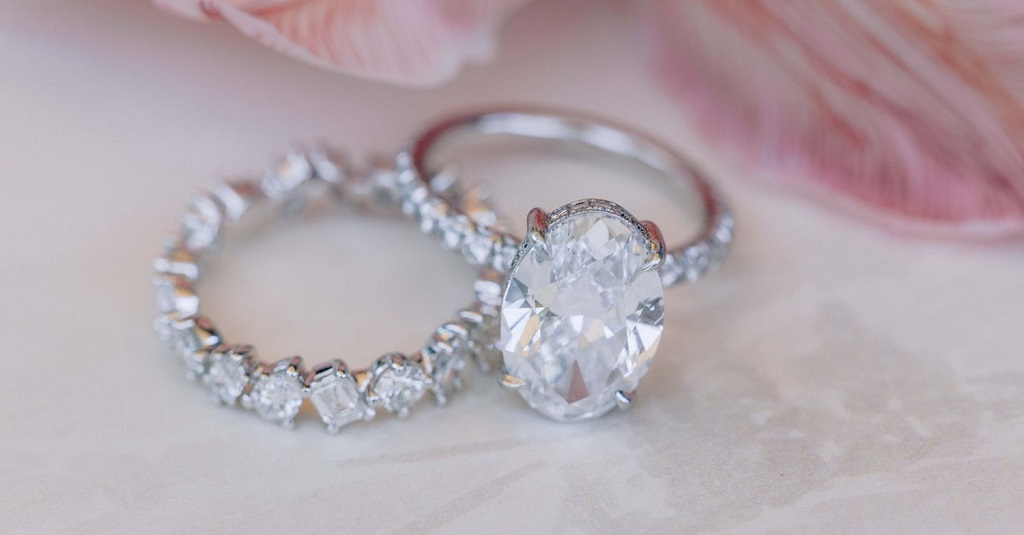
Your wedding ring will become an everyday accessory, so finding a comfortable and safe placement for regular wear is vital. Here are some factors to keep in mind:
- Avoid ring accidents. Placing rings too close to the tips of your fingers can increase the risk of rings getting caught on surfaces or objects. This can cause injury or lead to losing your ring. Wearing above the knuckle joint is safest.
- Consider your lifestyle. Think about your daily activities. Do you work with your hands or engage in sports or hobbies where rings could interfere or get damaged? Opt for a safer spot or remove during high-risk activities.
- Size appropriately. Ill-fitting rings are one of the top reasons for ring-related accidents. Ensure your wedding band is professionally sized to fit comfortably on your finger to limit spinning or sliding that can lead to getting caught.
- Check for swelling. Swelling in hands or fingers during pregnancy, for medical reasons, or from fluid retention can make rings uncomfortable or dangerous to wear if too tight. See a jeweler about temporary sizing adjustments when needed.
- Mind painful knuckles. For those with arthritis or joint pain in the hands, wearing a ring directly on a painful knuckle joint can intensify discomfort. Move your ring slightly above or below the knuckle for more comfort.
Putting safety first when deciding where to wear your ring keeps this exceptional jewelry protected and lets you feel comfortable wearing your ring daily without worry.
Popular Ring Finger Placement Options
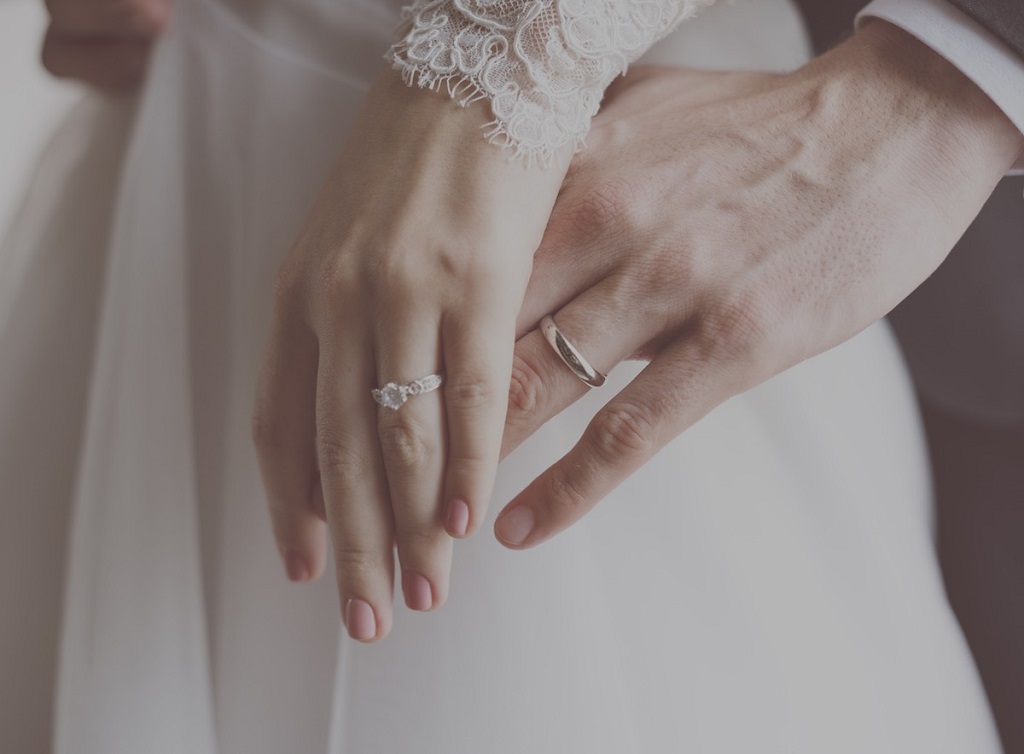
Where should you place the ring once you consider etiquette and safety factors? Here are some of the most popular and practical options for wearing your wedding band.
Knuckle Placement
Placing your wedding ring on your knuckle, the bone joint closest to the tip of your finger, has some distinct advantages:
- Good visibility. Rings are prominently displayed on the knuckle.
- Reduced risk of loss. More snugly fitting rings are less likely to slide off or get accidentally pulled off the finger.
- Follows tradition. In Western cultures, prominent knuckle placement is traditional.
- Easier sizing. Rings fit best when sized specifically for the knuckle width.
However, the snug fit can also mean:
- Potential discomfort. Rings fitting too tightly on knuckles can pinch or restrict movement.
- More accidents. Snug rings are prone to getting caught on surfaces.
- Difficulty removing. Tight knuckle rings can be hard to slide on and off.
Knuckle placement works best for those without arthritis or swelling who want a secure fit. Opt for comfort over perfect visibility or tradition if needed.
Below Knuckle
Placing your ring slightly below the knuckle joint avoids some of the pitfalls of knuckle wear while keeping the ring visible. Benefits include:
- It reduced pinching or pain. More room below the knuckle prevents discomfort from swelling.
- Safer for active lifestyles. Lower placement is less likely to catch on objects.
- Easier to remove. The looser fit makes taking rings on and off simpler.
- Accommodates changes. If your knuckles expand later in life, the ring position has room to shift.
The tradeoffs of below-knuckle wear:
- Increased risk of losing. The looser fit means rings can slide off more easily.
- Less prominent visibility. The ring sits slightly lower on the finger.
- It may spin or slide. Ill-fitting rings could rotate or move out of position.
Those with joint pain or highly active lifestyles get comfort and safety from below-knuckle placement. Adding grip pads inside the band can reduce spinning.
Above Knuckle
Placement above the knuckle joint is growing in popularity for the perks it offers:
- Extra security. The wider finger width higher up resists ring sliding or loss.
- Pain-free. Being off the knuckle eliminates arthritis pinching or swelling issues.
- Fits fluctuating sizes. The ring still fits comfortably as fingers expand and contract through the day.
- Easy on and off. The looser fit makes taking rings on and off simple.
The possible cons include:
- Less visible. The ring sits higher up on the finger and may even spin.
- Spins more readily. Without knuckle snugness, spinning is more likely.
- Unconventional look. Placement above the knuckle joint has a more modern, casual vibe.
This placement works ideally for those with comfort needs or highly active lifestyles. Adding texture inside the band reduces the spinning likelihood.
Base of Finger
Placing rings at the very base of the finger closest to the palm is relatively uncommon but offers distinct advantages:
- Ultimate security. The widest finger width prevents ring loss. Rings won’t budge from this spot.
- Most pain-free. Being off the joints eliminates any pinching or arthritis discomfort.
- It is easiest to size. Minimal tapering means consistent width for sizing.
- Stays put. When worn so low, the band can’t shift up and down the finger.
The biggest downside is:
- Low visibility. This placement hides rings from a prominent view.
Those with chronic swelling, pain, or highly active lifestyles benefit most from this secure positioning. If visibility matters, consider a broader, more eye-catching band.
Middle of Finger
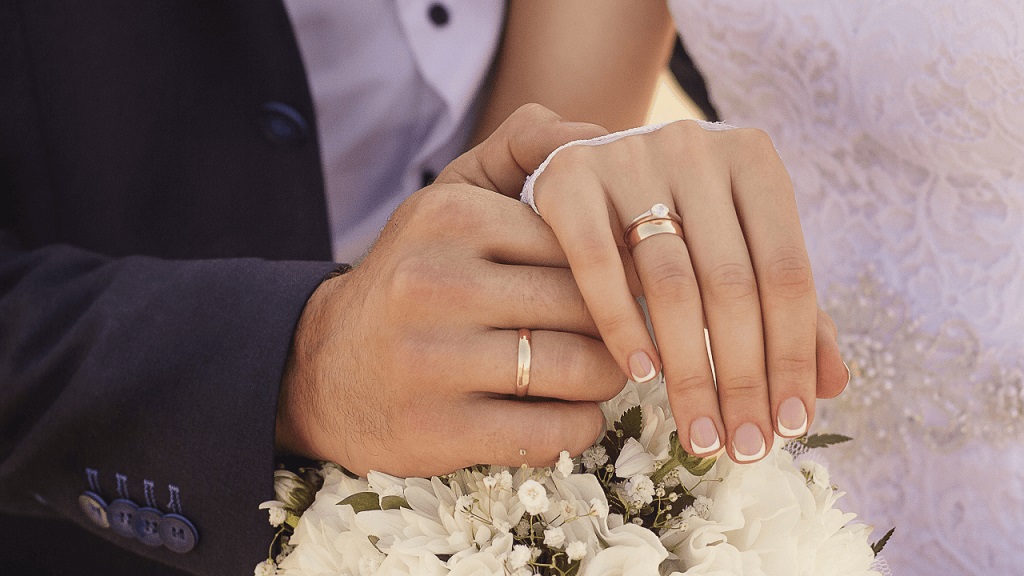
Wearing rings centered in the middle of your finger has become trendy with stacked ring styles. Benefits include:
- Lots of visibility. Center placement puts the ring(s) front and center.
- More options. Allows wearing multiple bands together.
- Avoid joints. Steers clear of potential knuckle pinching.
Downsides to mid-finger wear are:
- Increased spinning. Without snugness, bands spin more freely.
- Higher loss risk. The loose fit means rings can slide off more easily.
- Unconventional. Minimal traditions guide mid-finger placement.
This fun, trendy placement works best for lower-profile bands and ring stacks. Adding grip pads reduces spinning potential.
Tips for Making Your Ring Wear Comfortable
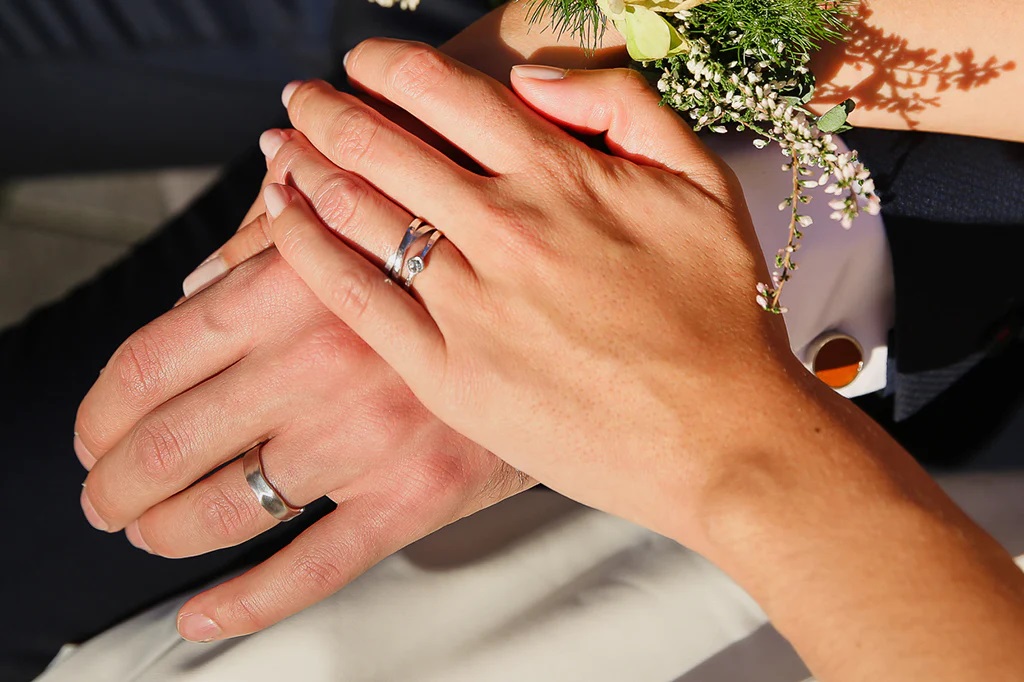
Once you choose the placement for your wedding ring, some additional tips can keep your ring wearing comfortable and safe long-term:
- Size regularly. Fingers change over time. See your jeweler annually to check proper size, especially during significant weight loss/gain, pregnancy, and arthritis.
- Consider fit. If sized too loose or tight, spinning, pinching, and losing are more likely. Erring slightly oversized typically causes fewer issues.
- Try bending. Gently bending the sides of your ring band slightly can create light pressure on the edges of your finger to reduce spinning.
- Add textures. Tiny beads, bumps, or grooves added inside the band provide grip to minimize sliding and spinning.
- Wear a snug guard. An optional metal ring guard tight to the base of your finger can stop bands from sliding up and down.
- Remove danger. Always take rings off for heavy manual labor, electrical work, or sports where rings pose accident risks.
- Give your fingers a break. At the end of the day or during periods when your hands are swollen, take the ring off temporarily to give your fingers a rest.
- Visit a jeweler. If you experience persistent pinching, pain, embedded rings, raw skin, or other issues, see a jeweler promptly about potential resizing or shaping needs. Don’t try DIY ring adjustments.
- Consider alternates. Those with metal allergies or comfort issues may opt for alternative ring materials like silicone, rubber, wood, or ceramic that flex more.
The most crucial rule is listening to your body. Adjust the placement or fit anytime your ring becomes painful, inconvenient, or hazardous during regular activities. You can enjoy wearing this unique token of love comfortably and safely for decades with some care and adjustments!
Frequently Asked Questions
What finger do you wear your wedding ring on?
In most Western cultures, wedding rings are worn on the fourth finger of the left hand, known as your “ring finger.” This tradition comes from the ancient Roman belief that a vein in this finger led directly to the heart.
Which hand is the wedding ring worn on?
Typically, wedding rings are worn on the left finger for both men and women in places like the United States, Canada, and the UK. Some exceptions include Germany, Poland, and Ukraine, where rings are worn on the right hand. The hand you choose can be based on cultural traditions or personal comfort.
Where should my wedding ring sit on my finger?
Most couples place the wedding ring directly on the knuckle joint closest to the fingertip. But those with arthritis or very active lifestyles may prefer wearing the band slightly above or below the knuckle for comfort and to prevent losing rings.
Is it wrong to wear rings below the knuckle?
There’s no right or wrong way to wear your wedding ring as long as it’s comfortable. Placement is becoming more popular below-the-knuckle to accommodate swelling, arthritis, injuries, or adjust ill-fitting rings. This position is secure enough for most people’s lifestyles.
How tight should a wedding ring fit?
The ideal fit is snug enough that the ring won’t easily slide up and down or risk falling off. But it shouldn’t pinch, compress knuckles, or restrict circulation. Leaving a tiny bit of wiggle room allows for swelling or knuckle size changes over time. Rings should glide on and off without too much effort.
Can I permanently resize my wedding ring?
Yes, a jeweler can resize wedding rings by either adding or removing small amounts of metal from the band. Full sizes up or down are usually possible without compromising the ring’s structure. But dramatic resizing like multiple sizes may not be possible for smaller diamond rings. Check with your jeweler.
Conclusion
Finding the ideal spot to wear your beloved wedding ring is a personal choice based on comfort, safety, lifestyle, and cultural traditions. Whether you opt for traditional knuckle placement, slightly above or below the joint, or somewhere entirely new, focus on finding a fit and position that keeps your ring secure while allowing you to wear it comfortably 24/7. Discover the key to making your wedding unique and unforgettable by choosing timeless elements that reflect your personality, and just like adjusting the placement of a cherished ring over the years as your hands change, adapt the details to evolve with the beautiful journey of your love story. With some thoughtful consideration now, you can ensure your wedding ring is worn happily every day for all the years to come.


